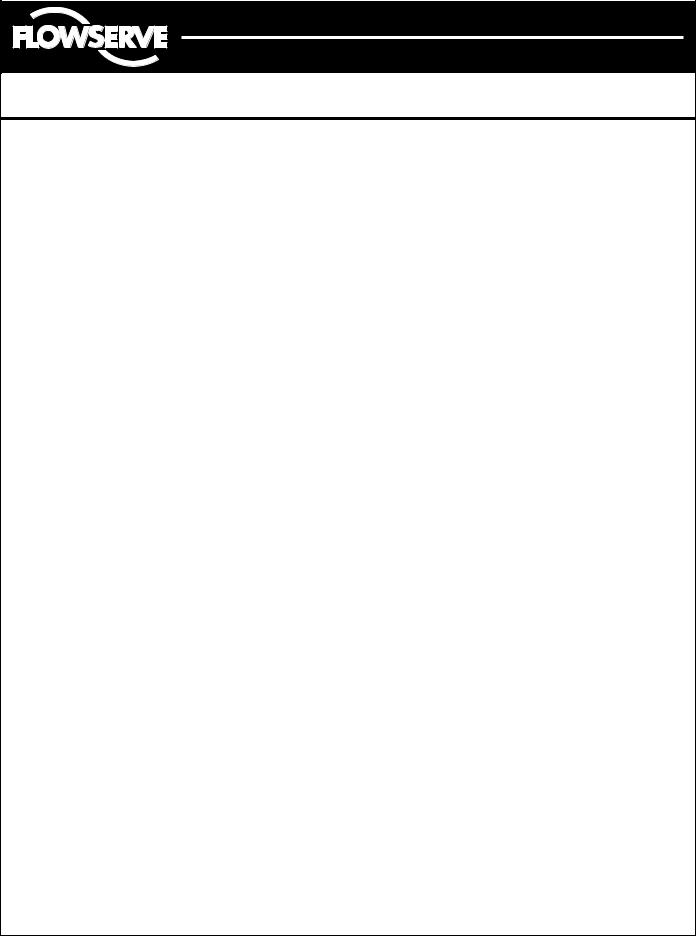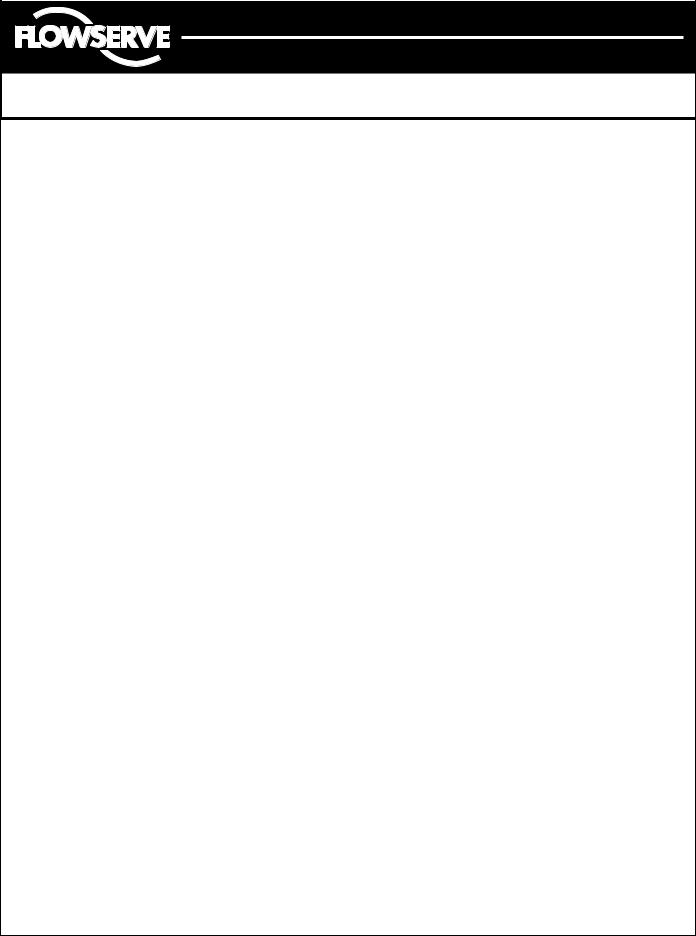Flowserve Heavy Duty Actuator User Manual

Automax Valve Automation Systems
Installation, Operation and Maintenance Instructions
Flowserve Corporation |
765 South 100 East |
Phone: 801 373 3028 |
Flow Control Division |
Provo, Utah 84606 |
Facsimile: 801 489 2228 |
Automation Business Unit |
www.flowserve.com |
E-mail: actuators@flowserve.com |
|
|
|
Heavy Duty Actuator
Installation Instructions
1.All actuators are factory lubricated for life, but still should be protected from the elements and stored indoors until ready for use. The ports of the actuator are plugged as supplied from the factory. If actuators are stored for a long period of time prior to installation, the units should be stroked every 3 months to prevent the seals from taking set.
2.Prior to assembly, manually open and close valve
to insure freeness of operation. Be sure valve and actuator rotate in the same direction and are in the same position (i.e., valve closed, actuator closed).
3.Check the mounting surfaces, the stem adaptor and the bracket to assure proper fit. Secure the valve in the closed position with the stem vertical. Bolt the bracket to the valve and place the stem adaptor on the valve stem. Position the actuator over the valve and lower to engage the stem adaptor to the actuator shaft. Continue to lower until the actuator seats on the bracket mounting surface. In order to align the bolt holes, it may be necessary to turn or stroke the actuator a few degrees and/or adjust the actuator travel stops. Bolt the actuator to the bracket.
4.After consulting the valve manufacturer's recommendations, adjust the travel stop bolts of the actuator for
the proper open and closed valve positions. Pneumatically stroke the actuator several times to assure proper operation without binding of stem adaptor. If the actuator is equipped with an Ultraswitch or other accessories adjust them at this time.
5.To prolong actuator life use only clean, dry plant air. Lubricated air is not required, however it is recommended particularly for high cycle applications. Caution: Do not use lubricated air with positioners.
Travel Stop Adjustments
All actuated valving requires accurate travel-stop adjustments at both ends of the stroke to obtain optimum performance and valve seat life. The accumulation of tolerances in the adaption of actuators to valves is such that there must be a range of adjustments for both ends of the stroke to achieve the expected performance. The
Heavy Duty series actuators have travel stop adjustments in both the clockwise and counter-clockwise directions. The 12 degree overtravel feature provides adjustments from -6 to +96 degrees.
Field Conversion from Fail CW to Fail CCW
(For Spring Return Actuators)
1.Apply supply air to actuator and loosen Stop Bolt Jam Nut (17) and back off clockwise Stop Bolt (16) to remove all spring cartridge preload.
2.Remove supply air from actuator.
3.Support Spring Cartridge (11) and loosen all 4 Nuts (41) evenly till all 4 nuts are loose. The spring cartridge does not have to be removed.
4.Remove the Position Indicator (44) or any other accessories that may be on the output shaft.
5.Remove the Bearing Retainer Screws (14) from the valve mounting side and slide the Retainer Plate (13) off the shaft.
6.The Torque Shaft (20) may now be tapped out using a soft faced hammer. Use care not to drop the shaft or the Bearing (12) when they come out.
7.Rotate Torque Shaft (20) end for end and reinstall into the Yoke (4) using care to line up the shaft with the Bearing (12) on the opposite end. Push the shaft thru till the shaft bottoms out. This should only require hand pressure to reinstall the shaft.
8.Reinstall the Bearing (12) back into the housing until it is flush with the top of the housing.
9.Reinstall the Bearing Retainer Plate (13) and Screws (14) insuring that the Gasket (37) is in place.
10.Tighten the Spring Cartridge Nuts (41) evenly until they are all 4 evenly tightened. See bolt torque chart.
11.Apply supply air to actuator and reset Stop Bolt (16). Never try to adjust stop bolt against force of spring.
12.Reinstall any accessories or position indicator on Torque Shaft (20).
13.Check actuator for proper operation.
14.The result of this operation is that the “valve” side of the actuator has been reversed.
A00032-1 GU |
(AUTO-9) |
5/01 |
Page 1 of 4 |
© 2001, Flowserve Corporation, Provo, UT

Automax Valve Automation Systems
Installation, Operation and Maintenance Instructions
Flowserve Corporation |
765 South 100 East |
Phone: 801 373 3028 |
Flow Control Division |
Provo, Utah 84606 |
Facsimile: 801 489 2228 |
Automation Business Unit |
www.flowserve.com |
E-mail: actuators@flowserve.com |
|
|
|
Maintenance Instructions
Disassembly Procedures
1.Disconnect all air and electrical supplies from actuator.
2.Remove all accessories from actuator and dismount from valve.
Spring Group (Spring Return Actuators)
1.Apply air pressure to the Pneumatic Cylinder to release spring pressure from the Stop Bolt (16). Remove both Stop Bolts (16) and release air pressure. This will relieve the majority of the spring preload.
NOTE: PERSONAL INJURY may result if Step 2 is attempted before Step 1 is completed.
2.The Spring Cartridge (11) is welded into an integral component and cannot be disassembled. To remove from actuator, remove Spring Cartridge Nuts (41) and Lockwasher (42). At this point, all spring forces are contained within the welded cartridge and the spring cartridge can be removed from the center body.
NOTE: Support the Spring Cartridge (11) during removal so as not to damage the Piston Rod (3).
Rod Cover (Double Acting Actuators)
1.Remove the Rod Cover Bolts (40) and Lockwashers (42). The Rod Cover (11) can now be removed from the Housing (1), taking care not to damage the Piston Rod (3).
Pressure Group
1.Remove the Tie Rod Nuts (28), Tie Rods (27), and the Endcap (29).
2.Slide the Cylinder (23) over and off the Piston (24), being careful not to scratch or dent the honed and chrome plated surface of the cylinder (23).
3.Remove the Piston Bolt (25), Piston Bolt Lockwasher
(26)and remove the Piston (24) and Piston Face Seal
4.Remove the Adaptor Bolts (43) and carefully slide the Adaptor (22) over the Piston Rod (3).
Housing or Body Group
1.Unscrew the Inspection Cover Screw (9) with Lockwashers (10) and remove the Cover (8) and the Cover Gasket (35).
NOTE: Prior to disassembly of remainder of the Body Group, you should check visually through the inspection opening to determine whether further disassembly is necessary. If the Yoke (4), the Yoke Pin (5), and the
Yoke Pin Rollers (6) are in good condition, do not disassemble further.
2.To remove the Piston Rod (3) and Piston Rod Bearing (2), center the Yoke in the Mid or 45 degree position.
R2 Actuators: To remove the Yoke Pin Retainers (7), use snap ring pliers with 90 degree tips through the inspection cover opening. Turn the Piston Rod (3) to remove the Yoke Pin Rollers (6) and the Yoke Pin (5) through the inspection cover opening.
R3 and R4 Actuator: Remove both freeze plugs that are located in the Housing near the Bearing Retainer (13).
Through these openings the Snap Ring, Yoke Pin Retainers
(7) can be removed. The Yoke Pin Rollers (6) can now be slipped off the Yoke Pin (5), and the Yoke Pin (5) can be pushed through the Piston Rod (3) and out through the opening in the other side of housing.
Remove Piston Rod (3) and Piston Rod Bearings (2) at this time, using care not to scratch the surface of the Piston Rod.
3.Unscrew the Bearing Retainer Bolts (14) and remove the Bearing Retainer (13), the Retainer Gasket (37), and the Torque Shaft Seal (38) from the valve mounting side of the actuator.
4.The Torque Shaft (20) may be tapped out using a soft faced hammer. Use care not to drop the shaft or the Bearing (12) when they come out. After removal of the
Torque Shaft (20) repeat step 3 on accessory side.
A00032-1 GU |
(AUTO-9) |
5/01 |
Page 2 of 4 |
© 2001, Flowserve Corporation, Provo, UT
